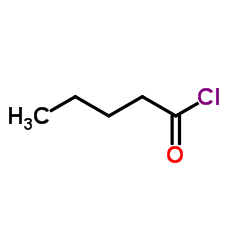Valeryl chloride

Valeryl chloride structure
|
Common Name | Valeryl chloride | ||
|---|---|---|---|---|
| CAS Number | 638-29-9 | Molecular Weight | 120.577 | |
| Density | 1.0±0.1 g/cm3 | Boiling Point | 128.4±3.0 °C at 760 mmHg | |
| Molecular Formula | C5H9ClO | Melting Point | -110 °C | |
| MSDS | Chinese USA | Flash Point | 32.8±0.0 °C | |
| Symbol |



GHS02, GHS05, GHS06 |
Signal Word | Danger | |
|
Use of multivariate statistical techniques to optimize the separation of 17 capsinoids by ultra performance liquid chromatography using different columns.
Talanta 134 , 256-63, (2015) In this work a multivariate statistical tool (Derringer and Suich optimization) was proposed for the separation of seventeen capsinoids (natural and synthetic) using the UHPLC-DAD chromatography. Capsinoids were analyzed at 280 nm. The variables optimized wer... |
|
|
The enantiomers of the valproic acid analogue 2-n-propyl-4-pentynoic acid (4-yn-VPA): asymmetric synthesis and highly stereoselective teratogenicity in mice.
Pharm. Res. 9(7) , 850-5, (1992) The teratogenic activities of R(+)- and S(-)-2-n-propyl-4-pentynoic acid (R and S-4-yn-VPA), the enantiomers of the highly teratogenic valproic acid (VPA) analogues (+/-)-4-yn-VPA, were investigated in mice. The enantiomers were prepared via asymmetric synthe... |
|
|
Enantioselective synthesis and teratogenicity of propylisopropyl acetamide, a CNS-active chiral amide analogue of valproic acid.
Chirality 11(8) , 645-50, (1999) Propylisopropyl acetamide (PID), an amide analogue of the major antiepileptic drug valproic acid (VPA), possesses favorable anticonvulsant and CNS properties. PID contains one chiral carbon atom and therefore exists in two enantiomeric forms. The purpose of t... |